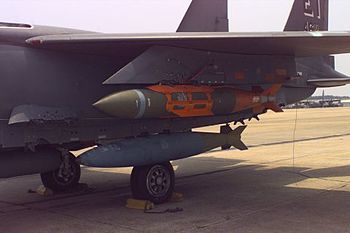BLU-109 bomb
| BLU-109 | |
|---|---|
 A BLU-109 aboard an F-15E Strike Eagle configured as a JDAM | |
| Type | Free-fall penetration bomb (guided when equipped as JDAM or Paveway) |
| Place of origin | United States |
| Specifications | |
| Mass | 1,927 lb (874 kg) |
| Length | 7 ft 11 in (2.4 m) |
| Diameter | 14.6 in (370 mm) |

The BLU-109/B is a hardened penetration bomb used by the United States Air Force (BLU is an acronym for Bomb Live Unit). As with other "bunker busters", it is intended to smash through concrete shelters and other hardened structures before exploding. In addition to the US, it is part of the armament of the air force of Australia, Belgium, Canada, Denmark, France, Germany, Greece, Italy, Israel, the Netherlands, Norway, Saudi Arabia, United Kingdom and United Arab Emirates.[1]
Design
The BLU-109/B has a steel casing about 1 inch (25.4 mm) thick, filled with 530 lb (240 kg) of Tritonal. It has a delayed-action tail-fuze. The BLU-109 entered service in 1985. It is also used as the warhead of some marks of the GBU-15 electro-optically guided bomb, the GBU-27 Paveway III laser-guided bomb, and the AGM-130 rocket-boosted weapon. This weapon can penetrate 4–6 feet of reinforced concrete,[2] which is greater than the 3 foot capability of the Small Diameter Bomb.[3] The BLU-109 is not likely to be retired anytime soon, due to the much larger blast capable from its warhead.[citation needed]
Variants
The BLU-118 is reportedly a thermobaric explosive filler variation on the BLU-109 casing and basic bomb design.[4] It contains PBXIH-135, a traditional explosive.[5]
In 2015 GD started a $7.2 million development of a version called HAMMER, which is intended to destroy chemical and biological substances by spreading dozens of Kinetic Fireballs Incendiaries (KFI) (not explosions) inside a bunker. The KFIs have evolved out of the Small Business Innovation Research (SBIR) program by Exquadrum, Inc. of Adelanto, CA.[6]
See also
Operators
The BLU-109 has been sold to key US allies including Israel, Saudi Arabia, UAE and Turkey[7]
 United States: United States Air Force
United States: United States Air Force Turkey: Turkish Air Force
Turkey: Turkish Air Force Israel: Israeli Air Force
Israel: Israeli Air Force Saudi Arabia: Royal Saudi Air Force
Saudi Arabia: Royal Saudi Air Force UAE: United Arab Emirates Air Force
UAE: United Arab Emirates Air Force
References
- ^ Forecast International (2004). BLU-116/B, page 4. Accessed 12 May 2011.
- ^ "BLU-109 / I-2000 / HAVE VOID". globalsecurity.org. Retrieved 15 March 2014.
- ^ "Small Diameter Bomb". Boeing. Retrieved 15 March 2014.
- ^ "BLU-118/B Thermobaric Weapon". GlobalSecurity.org. Retrieved 2013-12-06.
- ^ Little, Robert. "A race to get a new bomb for cave war". The Baltimore Sun. Retrieved 5 April 2014.
- ^ Drew, James. "Pentagon taps General Dynamics to test fireball bunker bomb"
- ^ The Most “Political” of All Bombs. http://www.quatrostrategies.com/2016/02/29/the-most-political-of-all-bombs/
